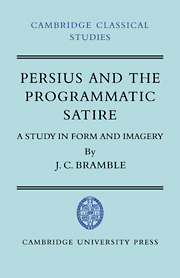Book contents
- Frontmatter
- Contents
- PARENTIBUS OPTIMIS
- Preface
- Abbreviations
- INTRODUCTION
- 1 STYLE AND EXPRESSION IN PERSIUS' FIFTH SATIRE
- 2 THE PROGRAMMATIC SATIRE AND THE METHOD OF PERSIUS I
- 3 THE NATURE AND SOURCES OF PERSIUS' IMAGERY
- 4 PERSIUS' FIRST SATIRE: ANALYSIS
- 5 GRANDEUR AND HUMILITY: JUVENAL AND THE HIGH STYLE
- APPENDIX 1 Accius and Pacuvius at Persius I. 76–8
- APPENDIX 2 Virgil and the moderns at Persius I. 96
- APPENDIX 3 The image of the child in ancient satire and diatribe
- APPENDIX 4 The disclaimer of malice
- TEXT
- TRANSLATION
- 1 INDEX OF MODERN AUTHORS
- 2 INDEX LOCORUM POTIORUM
- 3 INDEX OF IMAGES, TOPICS AND WORDS
INTRODUCTION
from PARENTIBUS OPTIMIS
Published online by Cambridge University Press: 05 June 2014
- Frontmatter
- Contents
- PARENTIBUS OPTIMIS
- Preface
- Abbreviations
- INTRODUCTION
- 1 STYLE AND EXPRESSION IN PERSIUS' FIFTH SATIRE
- 2 THE PROGRAMMATIC SATIRE AND THE METHOD OF PERSIUS I
- 3 THE NATURE AND SOURCES OF PERSIUS' IMAGERY
- 4 PERSIUS' FIRST SATIRE: ANALYSIS
- 5 GRANDEUR AND HUMILITY: JUVENAL AND THE HIGH STYLE
- APPENDIX 1 Accius and Pacuvius at Persius I. 76–8
- APPENDIX 2 Virgil and the moderns at Persius I. 96
- APPENDIX 3 The image of the child in ancient satire and diatribe
- APPENDIX 4 The disclaimer of malice
- TEXT
- TRANSLATION
- 1 INDEX OF MODERN AUTHORS
- 2 INDEX LOCORUM POTIORUM
- 3 INDEX OF IMAGES, TOPICS AND WORDS
Summary
At the end of the Satyricon, by means of a simple play on the verb comedere, Petronius creates an horrific scene in which a dying man requests that his body be eaten by his legatees. All that Petronius has done is remind his reader of the literal sense of a verb frequently used as a metaphor for squandering an inheritance. Concrete embodiment of commonplace metaphor is likewise found at the opening of Persius' third satire, where the vocabulary of philosophical enlightenment, signalised by clarum mane and lumine, is interwoven with more mundane detail concerning windows and chinks in the shutters: metaphor is translated into the fabric of a realistic situation.
Most of the following pages are devoted to an examination of Persius' employment of a similar technique in his first satire – to a study of the way that he takes the concepts and metaphors of literary criticism back to their physical origins, so concretely dramatising an analysis of the causes of decadence in contemporary letters. I have attempted to find out why the composition has this particular form rather than any other, an enquiry which has involved speculation about the conceptual stage prior to actual composition. I have also dealt with the expressivist implications of the prelude to the fifth satire, and with Juvenal's adoption of the high style. Additional material relevant to, or arising from, my main concerns appears in excursuses or appendixes.
- Type
- Chapter
- Information
- Persius and the Programmatic SatireA Study in Form and Imagery, pp. 1Publisher: Cambridge University PressPrint publication year: 1974

